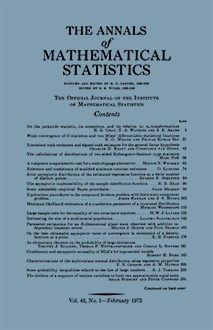Abstract
Recently interest has arisen in statistical applications of the bispectrum of stationary random processes. (The bispectrum can be thought of as the Fourier transform of the third-order moment function of the process.) The principal area of statistical harmonic analysis to receive attention previous to this time has been second-order (i.e. spectral) theory on which there is a vast literature. However, the spectrum is most useful in problems of a "linear nature" (see discussion beginning on p. viii of Blackman and Tukey [2]) and provides insufficient information in nonlinear problems. A desire to study phenomena of a nonlinear character has attracted attention to the higher order theory. Such was the case, for example, in a recent study by Hasselmann, Munk and MacDonald [8] where the bispectrum is used in connection with oceanographic problems, among which, as the authors state, a number of interesting phenomena such as surf beats, wave breaking, and the energy transfer between wave components can be explained only by the nonlinearity of the wave motion. The bispectrum therefore provides a first glimpse at the nonlinear effects. It is the purpose of the present paper to discuss estimating the weighted and unweighted bispectral density given a set of observations of the process. The relevant properties (consistency and asymptotic unbiasedness) of the estimates are derived for certain general classes of processes.
Citation
M. Rosenblatt. J. W. Van Ness. "Estimation of the Bispectrum." Ann. Math. Statist. 36 (4) 1120 - 1136, August, 1965. https://doi.org/10.1214/aoms/1177699987
Information





